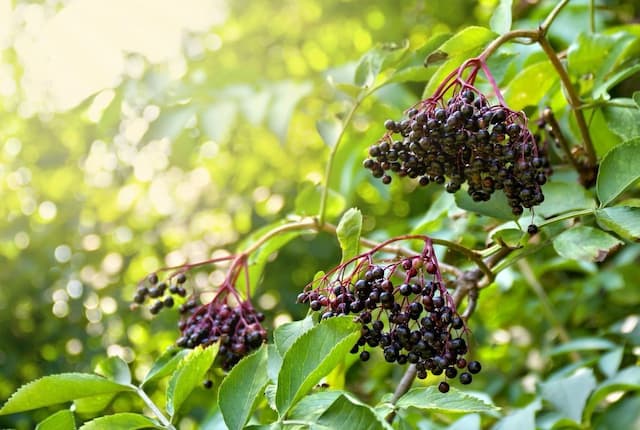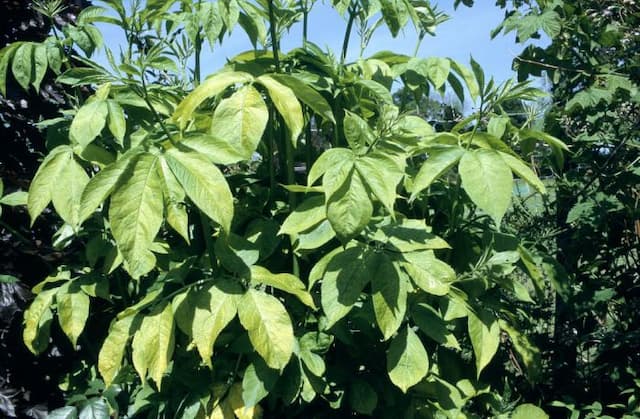Doublefile Viburnum Viburnum plicatum f. tomentosum 'Rowallane'

ABOUT
Viburnum plicatum f. tomentosum 'Rowallane', commonly known as the Japanese snowball, is a highly ornamental deciduous shrub, cherished for its striking and elegant appearance. The most distinguished feature of this plant is its layered, horizontal branching pattern that gives it a distinctive tiered effect, contributing to its classic, elegant look. In spring, the Japanese snowball is adorned with an abundance of lacecap flowers that bloom profusely along the branches. The edge of each flower cluster is surrounded by large, showy, white, sterile blossoms, while the center is filled with smaller, fertile flowers, creating a stunning contrast that can be likened to a lacy cap or a snowball. As the season progresses, these white blossoms may take on a soft pink tinge. The foliage of the Japanese snowball adds to its decorative appeal with leaves that exhibit a pleated or crinkled texture, hence the name "plicatum." These leaves showcase a fresh green color that transitions into a red to purple shade in the fall, providing a dramatic display of autumn color. Additionally, the Japanese snowball may produce attractive red berries that eventually mature into black, adding yet another layer of visual interest. Throughout its growing season, the Japanese snowball presents a harmonious blend of color, texture, and form, making it a popular choice for gardens desiring a touch of timeless beauty and structured elegance.
About this plant
 Names
NamesSynonyms
Japanese Snowball, Doublefile Viburnum
Common names
Viburnum plicatum var. tomentosum 'Rowallane', Viburnum tomentosum 'Rowallane'.
 Characteristics
CharacteristicsLife cycle
Perennials
Foliage type
Deciduous
Color of leaves
Green
Flower color
White
Height
8-10 feet (2.4-3 meters)
Spread
6-8 feet (1.8-2.4 meters)
Plant type
Shrub
Hardiness zones
5
Native area
Japan China
Benefits
 General Benefits
General Benefits- Ornamental Appeal: The plant is highly valued for its showy, layered horizontal branches and large, lace-cap like flowers that enhance garden aesthetics.
- Seasonal Interest: It offers multi-season interest with spring blooms, summer berries, and attractive fall foliage, making it a versatile landscape choice.
- Wildlife Attraction: This variety of Viburnum is known for attracting birds who feed on its berries, thereby supporting local biodiversity.
- Low Maintenance: Requires minimal care once established, making it suitable for gardeners at all levels of expertise.
- Drought Tolerance: Once established, it is fairly drought-tolerant, reducing the need for frequent watering and resource usage.
- Privacy Screen: Its dense growth habit makes it an excellent choice for use as a privacy screen or hedge.
- Soil Adaptability: The plant can thrive in a variety of soil conditions, which allows for flexible garden planning.
 Medical Properties
Medical PropertiesThis plant is not used for medical purposes.
 Air-purifying Qualities
Air-purifying QualitiesThis plant is not specifically known for air purifying qualities.
 Other Uses
Other Uses- The dense branching habit of the Doublefile Viburnum can be utilized for creating privacy screens in residential gardens or parks.
- The wood of Doublefile Viburnum is sometimes used in the production of small wooden objects such as tool handles, due to its firm consistency.
- This plant's strong branches are favorable for crafting rustic garden trellises or supports for other climbing plants.
- Doublefile Viburnum's ornamental berries can be used for creating natural dyes, providing a range of colors from shades of pink to blue-black.
- The plant can be incorporated into permaculture designs as a hedgerow, providing habitat and food for beneficial insects and birds.
- As a specimen with distinctly textured leaves, Doublefile Viburnum can be used in sensory gardens designed for educational and therapeutic purposes.
- The dense foliage and layered structure make it suitable for use in noise-reduction plantings along roads and highways.
- In landscape design, its broad, spreading growth pattern can be employed to cover ground and reduce soil erosion on slopes.
- The flowers can be used as a natural confetti at events and weddings when a biodegradable option is desired.
- When dried, its blooms can be incorporated into potpourri mixes to add visual appeal and a subtle natural fragrance.
Interesting Facts
 Feng Shui
Feng ShuiThe Doublefile Viburnum is not used in Feng Shui practice.
 Zodiac Sign Compitability
Zodiac Sign CompitabilityThe Doublefile Viburnum is not used in astrology practice.
 Plant Symbolism
Plant Symbolism- Renewal: The Doublefile Viburnum, as a flowering shrub that blooms with the onset of spring, symbolizes renewal and the beginning of new cycles.
- Abundance: Its lush blossoms and generous growth make it a symbol of abundance and prosperity.
- Perseverance: As a hardy plant that can thrive in various conditions, the Doublefile Viburnum signifies the ability to persevere through challenges.
- Beauty: With its elegant flowers arranged in symmetrical rows, this plant is often associated with beauty and aesthetic appreciation.
- Protection: In some cultures, the Doublefile Viburnum's dense foliage is seen as a symbol of shelter and protection.
 Water
WaterThe Doublefile Viburnum requires consistent moisture, especially in the first few growing seasons. Water deeply once a week, applying about 1.5 gallons per watering to thoroughly soak the root zone. During periods of drought or extreme heat, the frequency may need to increase to twice a week to maintain soil moisture. Avoid shallow sprinkling, as it encourages weak root development. Always check the top few inches of soil for dryness before watering to ensure the plant is not overwatered.
 Light
LightThe Doublefile Viburnum thrives in full sun to partial shade. The ideal location is one where the plant receives at least 4 hours of direct sunlight each day, with some afternoon shade to protect from the intense late-day sun. A spot with dappled sunlight or morning sun with late afternoon shade is also suitable for healthy growth and flowering.
 Temperature
TemperatureThe Doublefile Viburnum can tolerate a range of temperatures and is hardy from USDA zones 5 through 8. It can withstand minimum temperatures down to -20°F and maximum temperatures up to 90°F. The ideal temperature for promoting growth and flowering is between 60°F and 80°F.
 Pruning
PruningPrune the Doublefile Viburnum immediately after flowering to maintain its shape and encourage healthy growth. Cut back the branches that have just flowered to a point of strong, outward-facing buds to stimulate new growth and flower production. Pruning is typically required once a year, but light trimming to remove dead or broken branches can be done as needed throughout the year.
 Cleaning
CleaningAs needed
 Soil
SoilJapanese Snowball (Viburnum plicatum f. tomentosum 'Rowallane') thrives in moist, well-drained soil that's rich in organic matter with a pH range of 5.5 to 6.5. For optimal growth, mix garden soil with compost or peat moss to enhance fertility and water retention. Regular mulching will help maintain soil moisture and temperature.
 Repotting
RepottingJapanese Snowball doesn't typically require frequent repotting if planted in the ground. For container-grown specimens, repot every 3-5 years or when roots outgrow the pot, usually in late winter or early spring before new growth begins.
 Humidity & Misting
Humidity & MistingJapanese Snowball prefers moderate humidity levels but is generally tolerant to the varying humidity conditions found in most outdoor environments. It does not have specific humidity requirements when grown in its ideal outdoor setting.
 Suitable locations
Suitable locationsIndoor
Not ideal for indoor growth, needs sunlight.
Outdoor
Plant in partial shade, moist soil, mulch yearly.
Hardiness zone
5-8 USDA
 Life cycle
Life cycleThe life of Viburnum plicatum f. tomentosum 'Rowallane', commonly known as Doublefile Viburnum, begins with seed germination, typically in spring to early summer, in well-drained soil with adequate moisture. Seedlings emerge and grow into juvenile plants, developing a strong root system and the characteristic horizontally tiered branches. The plant enters its vegetative stage, producing dense, green foliage, and as it matures, it begins the reproductive stage, blooming in late spring with showy, lace-cap flowers attractive to pollinators. Following pollination, the flowers give way to red berry-like drupes that mature to black, providing food for birds and completing the reproductive cycle. The plant then enters a period of dormancy during the winter months, conserving energy for the next growing season. Across years, the plant continues to grow in size and spread, potentially reaching up to 10 feet tall and wide, with the cycle of flowering and seed production occurring annually.
 Propogation
PropogationPropogation time
Spring-Early Summer
The most popular method of propagating the Japanese Snowball, scientifically named Viburnum plicatum f. tomentosum 'Rowallane', is through softwood cuttings. This technique is often carried out in the late spring or early summer when new growth is still tender and green. To propagate, one should cut a 4 to 6-inch (10 to 15 centimeters) length of stem from a healthy part of the plant, ensuring there are a couple of leaves on the cutting. After removing the leaves from the lower half, the cut end can be dipped into a rooting hormone to encourage root growth. The treated cutting is then placed into a well-draining potting mix, with good moisture, and kept under indirect light until roots develop, which typically takes several weeks. Maintaining a humid environment by covering the cutting with a plastic bag can help improve the chances of successful rooting.



![Elder [Black Tower]](/_next/image?url=https%3A%2F%2Fplants-admin.emdemapps.com%2Fimages%2Fplants%2F%2Fimages%2F604b5cad99578.png&w=640&q=75)





